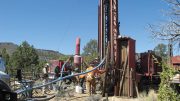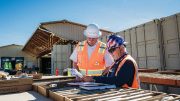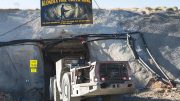Liberty Gold (TSX: LGD) has completed the first resource estimate on its flagship, wholly owned Goldstrike oxide gold project in southwestern Utah.
The project lies near the Nevada border in the eastern Great Basin and hosts a Carlin-style gold system that allowed past producers to mine 209,000 oz. gold from 12 shallow pits between 1988 and 1994.
But these previous operators didn’t explore extensively, Liberty Gold says, and now its first resource — 75% of which is in the indicated category — marks the first big step in turning the 24-year-old past producer into a modern, multimillion-ounce mining project.
Based on historic and Liberty Gold drilling in 1,730 tightly spaced holes, the project has indicated resources of 865,000 oz. gold from 49.6 million tonnes grading 0.54 gram gold per tonne, and inferred resources of 274,000 oz. gold from 16.4 million tonnes at an average grade of 0.52 gram gold. The resource is based on 153,000 metres of drilling and uses a cut-off grade of 0.25 gram gold.
“When you’re going over a million ounces of Carlin-style, heap-leach gold, that’s something that changes the net asset value of a public company,” Cal Everett, the junior explorer’s president and CEO, says in a telephone interview. “When you come out with over 1 million oz., that’s a benchmark that producers look at.”
Moira Smith, the company’s vice-president of exploration and geoscience, notes that the tightly spaced drill holes give her confidence in the resource, and says it’s “very defensible and will stand the test of time.”
“The benchmark that we’re using is to come up with an operation that is a minimum 100,000 oz. per year gold producer with a minimum mine life of eight years — that’s our internal benchmark, which we think is the same as the market’s,” she says, noting that with 80% recoveries of leachable gold at Goldstrike, Liberty Gold has reached that threshold with its first resource.
Smith also notes that there are a lot of areas that have gold in the model but didn’t make it into the classified resource because the holes were too far apart, among other reasons, so she and her team can go back and look at those areas in greater detail this year.

A drill rig on the surface of Liberty Gold’s Goldstrike oxide gold deposit in Utah. Credit: Liberty Gold.
“We’ve already identified those areas. We know there’s gold in them, and we’ll go in and infill drill so we have hole density that will allow us to convert that, hopefully to a resource,” she says, adding that the best areas so far are in the Dip Slope zone, which occurs north of the main mineralization in the historic Hassayampa, Hamburg, Basin and Gold Town pits. The Dip Slope zone is open in several directions and is fairly sparsely drilled.
“We’ve drilled in and around and down dip of those historic pits and we call them the ‘main zones,’ and that’s where most of the resource is located,” Smith says. “That’s where we started our drilling. We said, ‘hey, they really only gouged the eyes out of these surface areas of mineralization, and there’s no reason why there wouldn’t be gold around and between and down dip of these pits.’ That was our initial exploration philosophy when we went in there, and we can say we demonstrated a great deal of continuity between those pits.”
In addition to building ounces through infill and step-out drilling this year in the Dip Slope zone north of the main mineralization, the company also expects to receive permits shortly that will allow it to get into previously disturbed areas, including old heap-leach pads, low-grade stockpiles and waste piles.
“There’s actually a lot of gold left in those areas,” Smith says. “We did a couple of holes into the historic heap-leach pad last year and the average grade was 0.3 or 0.4 oxide right on the surface. Someone else had already blasted it. So we want to drill off those pads and see how much gold is left. Another focus is on new discoveries — what else is there on the property and our existing permits gets us into a lot of those areas. Late last year we built road access into some of those areas, too, so they’re primed and easy to do, and hopefully we’ll make a few new discoveries along the way.”
Earlier this month Liberty Gold announced two shallow discoveries 1.5 km northwest and 1.5 km southwest of the project’s historic Beavertail pit, the most western pit on Goldstrike’s historic mine trend.
Drill hole 473 (northwest) returned 2.25 grams gold per tonne over 12.7 metres within an intercept of 24.4 metres grading 1.46 grams gold starting from 29 metres downhole, while drill hole 466 (southwest) returned 12.2 metres of 0.78 gram gold per tonne starting from 3 metres downhole.
Mick Carew of Haywood Securities said in a research note the two discoveries underscore that “much of the company’s project area remains unexplored, providing significant upside in terms of total resource growth,” and emphasized that the Dip Slope zone is open in several directions.
Highlights from drilling at Dip Slope last year include 2.39 grams gold over 7.6 metres within an intercept of 82.3 metres grading 0.91 gram gold in hole 461; 0.53 gram gold over 30.5 metres and 0.47 gram gold over 9.1 metres in hole 454; and 1.65 grams gold over 10.7 metres in hole 463.
Metallurgical test work last year that showed 80% recoveries is also key, Everett says.
“The grade of this deposit slides right into the mid-range of the producing mines in the Great Basin, yet the metallurgy is up at the upper end of recoveries, which is why it’s such an important discovery,” he says. “Our results show that we get approximately 80% of our leachable gold out within less than 10 days, so the gold pours out of these rocks.”
Everett adds that if you only have to blast it and put it on the heap-leach pad (eliminating the need for crushing and agglomeration) so that the rock is handled only once before you put it on the pad, it’s quite cheap to process. “A lot of people don’t understand,” he says. “But these are really big, earth-moving operations, and they’re really quite simple, and the capex to build them is quite cheap.”
The company raised $10.5 million in a financing that closed on Jan. 26, much of it taken up by Resource Capital Funds through the exercise of warrants. RCF now owns 12.1% of the company.
“They did due diligence inclusive of site visits over a prolonged period of time, and they did an exceptional amount of work,” Everett says. “They are a very smart geological group, so putting the book together didn’t take much time to get it all done. These are not hedge fund-type investors or institutional investors. They’re all mining people or mining institutions who really get it.”
Smith adds that 2018 will be a transformative year for the company.
“Up until now we’ve been very geologically and drilling focused, and the resource is a benchmark that kicks off the next growth phase of the project in turning it from strictly geology to a mining project, in the sense that we’re going to wrap some engineering and economics around it, and we’re looking at doing more metallurgical testing, more permitting, so that we can get into areas where our drill density isn’t high enough so we can drill them off,” she says.
“We’re looking at potential water sources, we’re doing a lot of community outreach to potential stakeholders — getting to know people in the community that will be affected by us. This is my favourite phase of a project where we go from a fairly narrow focus to building ounces and understanding geology to look at it holistically as a potential mining project, and doing all the de-risking and leading up to having a fully formed project.”
Smith says this is the same approach she and her team took when she worked for Fronteer Gold on the Long Canyon deposit in Nevada. Liberty Gold was spun out of Fronteer Gold after Newmont Mining (NYSE: NEM) acquired Fronteer in 2011, with Liberty Gold being launched with much of the team responsible for Fronteer’s success.






Be the first to comment on "Liberty Gold tables maiden resource for Goldstrike"